Perseverance, defined
During the worst health crisis befalling the country in more than 100 years, fall semester 2020 at University of Northern Iowa was more of the same -- yet different. What was unexpected in the spring became, in this moment, the new normal. Students successfully returned to campus -- and, for the most part, stayed through a shortened semester ending the day before Thanksgiving.
College of Education faculty learned from the spring, prepared through the summer and, this fall, just ...kept … adapting. They figured out seating charts for socially distant spacing, split classes into multiple sections, accommodated combinations of students in class and viewing via remote learning -- and went fully remote when needed.
A continuing challenge was maintaining the hands-on learning that the college and university is known for through its myriad of classroom and clinical field experiences. It proved somewhat smoother this fall. Schools were back in session, albeit with varying modes of delivery. For the most part, clinical partners and cooperating organizations welcomed student interns back on site as long as they followed specific masking, sanitizing and physical distancing guidelines.
Adjustment in the classroom
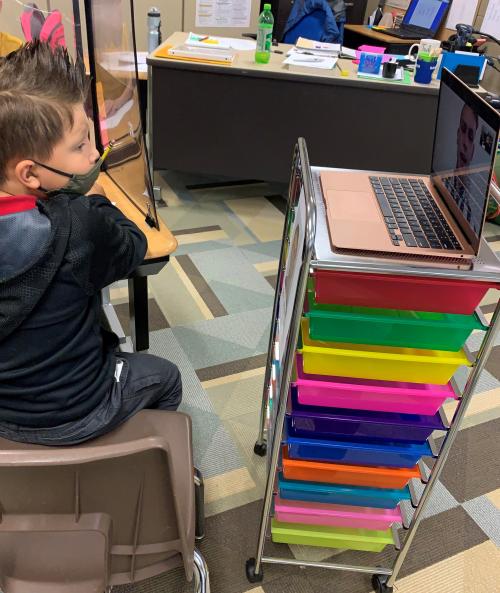 This scene is but one example of the effort, collaboration and adjustment which happened in classrooms hosting UNI students gaining early exposure to teaching in Level 1 and Level 2 field experiences this fall. Level 1 is intended to help answer the questions: Do you want to be a teacher? Are you suited for this? Do you have what it takes? Level 2 introduces students to hands-on lesson planning and delivery. Meeting the objectives for both had their challenges this past fall.
This scene is but one example of the effort, collaboration and adjustment which happened in classrooms hosting UNI students gaining early exposure to teaching in Level 1 and Level 2 field experiences this fall. Level 1 is intended to help answer the questions: Do you want to be a teacher? Are you suited for this? Do you have what it takes? Level 2 introduces students to hands-on lesson planning and delivery. Meeting the objectives for both had their challenges this past fall.
Kim Miller, College of Education Department of Teaching, is one of the field experience coordinators for Level 1 and Level 2. Last spring when the COVID-19 disruption began, most Level 1 students had completed much of their 25 hours of experience. This past fall, figuring out how to create opportunity for engagement, learning and observation was “totally different,” Miller says.
Of her 27 Level 1 placements, the majority were on site within classrooms, while nine students engaged virtually due to teacher preference and student choice. “The mentor teachers that volunteered have been fabulous. They have welcomed the UNI students even during this uncertain time,” she says.
Some UNI Level 1 students were virtual -- even quarantined -- and connecting remotely with students in a classroom. For a handful, everyone was remote -- UNI student, elementary student and teacher. All had to be more purposeful in their interactions to ensure a necessary level of engagement.
“Level 1 is a critical class, and I do think UNI does it better than anyone,” Miller says. But as COVID-19 has taught everyone, there is more than one way to achieve goals.
Making connections
During a final lesson by one group, the two paired students read a book online to the entire classroom who were on a big screen. They then moved into small groups, with the cooperating classroom teacher moving the computer around the class.
“The whole thing about Level 2, it’s about how to write a lesson plan, and they did get to deliver it, with some assistance. When they were done, the students gave the UNI virtual students cards and they were touched,” says Miller. “You can make a connection virtually. It is more difficult and has to be intentional, but it can happen.”
Miller, like all UNI field experience coordinators, was constantly juggling, adapting and learning. She recalled one week when she had Level 2 students delivering five lessons that she needed to monitor. With on-site observation currently limited, she could watch live or go back and watch later, and then debrief with students and the classroom teacher -- all virtually.
She knows there is a perspective missed by not being in the classroom. But all in all, everyone -- teachers, preservice students, students, para-educators -- made it work.
“We did the best we could and still created purposeful learning opportunities,” she says.
Higher levels, challenges and opportunities
Between logistics and an ongoing pandemic, the majority of Level 3 experiences--normally a one-week hands-on experience in a classroom in school districts around and beyond Iowa--remained virtual for most students.
The alternative? Teach via Zoom, which Robin Dada, head of curriculum and instruction, says provided an experience that faculty may continue to incorporate. “Our students preferred face-to-face, but were grateful for support to teach via Zoom and having to work through some of the issues of engagement as they preplanned for instruction at a distance from their students.”
Student teachers did teach, though for two seven-week instead of eight-week sessions, with some interesting twists (see Despite derecho, student teachers carry on).
"Student teachers seem so thankful to be connecting with their class, working closely with their cooperating teachers and teaching! My student teachers were in every conceivable configuration of teaching, from full face-to-face classes, all virtual to unique hybrid opportunities (same cohort two days a week, to mix of face-to-face and virtual classrooms),” says Cindy Cone, Omaha/Council Bluffs student teaching coordinator. “Schools have been creative in their response to COVID-19 and our student teachers are gaining many unique experiences this semester.”
Getting hands-on with athletic training
 After disruptions and interruptions in clinical experiences in the spring, students in the master’s of athletic training (MATR) program were able to fully resume hands-on training this fall.
After disruptions and interruptions in clinical experiences in the spring, students in the master’s of athletic training (MATR) program were able to fully resume hands-on training this fall.
“Our clinical experiences ran very similarly to what they have in the past -- with the addition of typical COVID policies (masks, shields, etc.),” says Tricia Schrage, assistant professor, athletic training, and coordinator of clinical education.
Second year MATR students completed a required four-week immersive experience into the day-to-day and week-to-week roles of an athletic trainer. For one student, that was on campus with UNI Athletic Training Services, and two completed the experience off campus at Columbus High School and Dike-New Hartford High School. Others gained experience in patient care with diverse patient populations and health conditions and at local family practice facilities (People's Community Clinic and Northeast Iowa Family Residency). Students were able to observe surgeries with Dr. Benjamin Torrez at Buchanan County Health Center later this fall.
“The students and preceptors all submitted first rotation and immersive experience evaluations and the feedback has been very positive. Students were able to engage in patient care and apply their knowledge and skills and, most importantly, progress towards graduation,” says Schrage.
Learning often requires hands-on skills training within coursework for pre-health degrees like athletic training and rehabilitation studies and the graduate MATR. Schrage teaches a course on equipment skills, while Kelli Snyder, associate professor and program director, teaches another focused on learning anatomy through palpation, or touching, joint range of motion measurement and neurovascular assessment.
As with other laboratory-type classes, the faculty needed to create protocols that met both university guidelines for safety and health within a pandemic while maintaining accrediting agency guidelines. This included the students working within the same small group during the semester, wearing masks and gloves and distancing as much as possible while using their hands to learn to touch, probe or apply equipment correctly during class exercises.
“Overall, clinical experiences this fall were a huge success," says Schrage. “We look forward to offering even more variety in the spring, including the ACE-SAP clinic (free medical clinic) in Waterloo where our students have gained unique experiences in the past.”
The outdoors as classroom
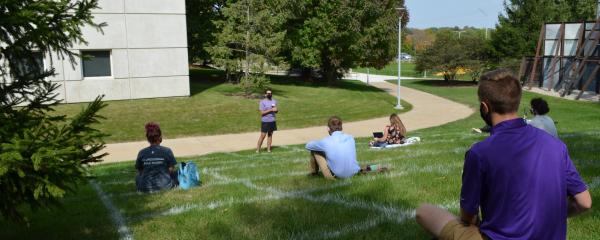 Learning while living within a pandemic brought added creativity elsewhere as well.
Learning while living within a pandemic brought added creativity elsewhere as well.
As an American resident and Canadian citizen, Rod Dieser perceives COVID-19 with multiple perspectives. The recreation, tourism and nonprofit leadership professor noticed the lighter impact within his home province of Alberta in comparison to Iowa and the United States.
He decided to move his fall classes outside when possible.
“One of the public health strategies in Canada, among many, are sound limits so people do not speak loudly in school and restaurant settings. I felt having any discussions in the classroom, especially passionate discussions, would be unsafe, and knew that being outside, with face coverings and social distance, was an epidemiological evidence-based practice that was safer,” he says. “This is all about science-based safety, going beyond the minimum levels of safety, and then having some class discussion.”
He found safety and learning can go together well. Weather permitting, he was outside for five hours teaching on Wednesdays. “I was shocked at how outstanding it's been. Students have overwhelmingly stated they ‘love it,’” he says. “I have had over 20 emails stating the outside experience has been excellent and students encouraging me to keep having the class outside.”
Due to spacing guidelines, some classes moved from smaller classrooms to larger -- or even in chairs set up in gymnasiums. Mauricio Nunez, assistant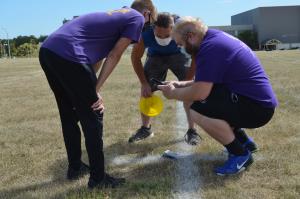 professor, kinesiology, and his fellow faculty are proud of the technology they can offer their students as part of their studies regarding exercise physiology and biomechanics. But working around the classroom guidelines also led to alternatives.
professor, kinesiology, and his fellow faculty are proud of the technology they can offer their students as part of their studies regarding exercise physiology and biomechanics. But working around the classroom guidelines also led to alternatives.
On a hill just west of the Wellness and Recreation Center, undergraduate biomechanics students discovered how to use free tools on their phones to conduct basic motion analysis techniques during activities such as swinging a bat or throwing a frisbee -- something they could safely use in outdoor coaching situations.
Staying focused in special education
When COVID-19 disrupted spring coursework, students working on their special education endorsements had been in their practicum classrooms for several weeks, knew the students and had begun teaching. School shutdowns led to alternative learning experiences. For example, the UNI students created lesson plans, recorded themselves teaching and then received feedback from faculty.
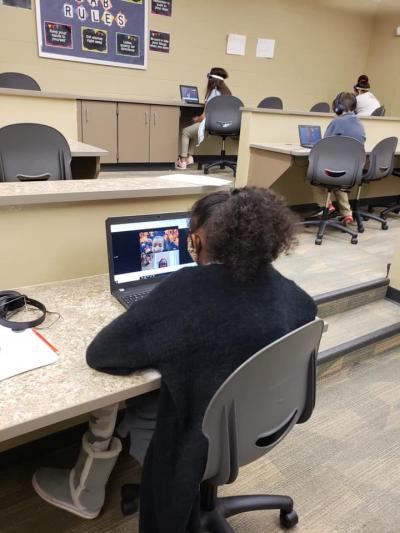 The fall would be different with UNI students engaging from the beginning in a world adapting to the pandemic. Yet, UNI special education faculty, who work with Becker Elementary School in Waterloo to provide practicum opportunities specific to special education, had a goal: to create and maintain a safe face-to-face learning opportunity for their students. Doing that would require preparation.
The fall would be different with UNI students engaging from the beginning in a world adapting to the pandemic. Yet, UNI special education faculty, who work with Becker Elementary School in Waterloo to provide practicum opportunities specific to special education, had a goal: to create and maintain a safe face-to-face learning opportunity for their students. Doing that would require preparation.
“We kept using the words flexible and pivot. We began working with Becker administration in the spring and summer to think through possibilities. How could we make it work if the children were in school? How could we make it work if a UNI or Becker student had to be away for a bit?” says Amy Staples, associate professor, special education.
The principal converted a computer lab to a special education workspace, so UNI and Becker students could be in a bubble of sorts, she says. From 9 a.m. to 2 p.m., children rotated through by grade level. Lora Hickman and Terre Hirst, field supervisors for special education, managed the comings and goings of UNI students, taking their temperatures upon entry -- and sending those with an elevated temperature home. The UNI and Becker students used hand sanitizer when entering and exiting the computer lab and wore face coverings throughout their sessions.
through by grade level. Lora Hickman and Terre Hirst, field supervisors for special education, managed the comings and goings of UNI students, taking their temperatures upon entry -- and sending those with an elevated temperature home. The UNI and Becker students used hand sanitizer when entering and exiting the computer lab and wore face coverings throughout their sessions.
Hickman and Hirst sanitized work stations in between each round of students, connected students to the UNI Student Health Center as needed, worked to ensure compliance with district and Iowa guidelines and kept everyone at Becker and UNI apprised of any developments.
“It took a massive amount of wrangling!” Staples says. “Due to planning and ongoing efforts by Lora and Terre, and the UNI students’ taking our guidelines seriously, we were able to remain in the school until just a few days before the practicum was slated to end.
“Our students understood that being in a school during this time was highly unusual, but they really felt teaching benefited them,” she says. “They were grateful for the opportunity to work with students every day for nearly nine weeks. They built relationships with their students, learned to design lessons that supported the students' needs and the work of the classroom, and to monitor students' progress. They saw teachers working during a challenging time and saw the flexibility and resilience of school staff and children.”
Profile: Hannah Gates, Level 1
Hannah Gates, an elementary education transfer student from LaPorte City, Iowa, was among those whose entire Level 1 field experience was virtual in fall 2020.
Initially, she was upset. Then, she says, “I realized I was going to get out of this experience what I put in.”
She more than accomplished her goal.
“I truly believe this was such a positive experience because I had the best mentor teacher to help me along with this journey,” she says, referring to Stacy Childs at Kittrell Elementary in Waterloo.
Gates joined classes via Google Meet and worked one-on-one with students on math.
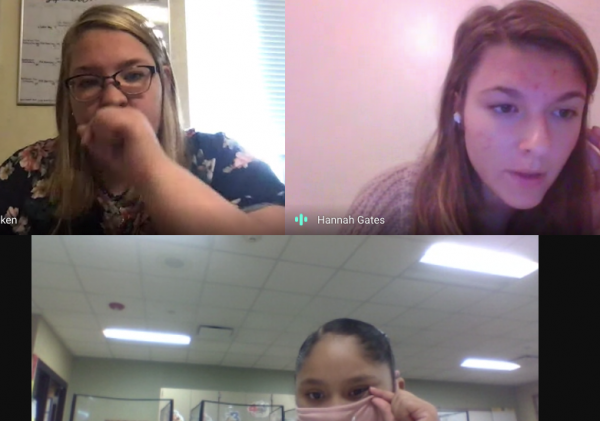 “The biggest thing I was worried about losing in a virtual Level 1 experience was getting the opportunity to build relationships with the students. I soon learned this was not going to be a problem,” she says. “I took the time to get to know the students and for the students to learn about me. This allowed me to develop a personal connection with them, so they were not just talking to a stranger through the computer.”
“The biggest thing I was worried about losing in a virtual Level 1 experience was getting the opportunity to build relationships with the students. I soon learned this was not going to be a problem,” she says. “I took the time to get to know the students and for the students to learn about me. This allowed me to develop a personal connection with them, so they were not just talking to a stranger through the computer.”
Gates also teamed up with her fellow Level 1 student, Kaitlyn Goedken, to prepare a tutorial on using Google Meet for students and, for teachers, a step-by-step guide on how to plan a meeting, the options in Google Meet and resources for online teaching.
“Teachers in the building needed to prepare to be able to go to virtual teaching at any time. The teachers were so grateful for this because it provided them with extra guidance through this difficult time,” she says.
The fall experience taught Gates the value of flexibility. “I learned to roll with what comes and make the most out of every situation. I am grateful to now be able to say that I do have experience teaching virtually,” she says. “It takes more time and effort, but can be done just as well as teaching in person. It is all about what you put into it!”
And how did Gates answer that question: Do you want to be a teacher?
“Teaching is most definitely for me,” she says. “I loved getting to know the students in the classroom and providing ways to further their understanding and education. This Level 1 experience has given me so much excitement for my future. I cannot wait for more experiences like this and to make an impact on the future students I meet.”
